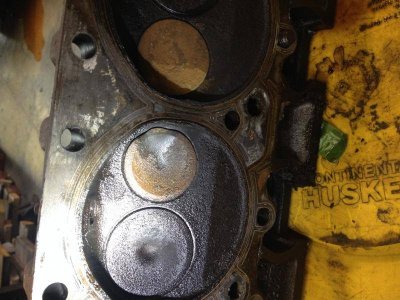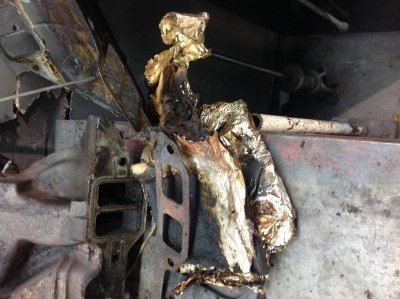As some of you know - I've suffered from a rough idle on my 73 Town and Country since I got it. With help from many of you I've rebuilt my thermoquad, checked for vacuum leaks and ignition failure areas all over the engine compartment.... The engine ran a little better each time but the lumpy idle just wouldn't go away... very frustrating as you can imagine. Well I finally found it and hear it is.
I finally decided to get serious. Going over to a friends shop which you may know from my posts on the B Bodies site, I was able to use his old SnapOn engine analyzer and I determined my burn time for all my spark plugs was right on spec, Wires had spec resistance and dwell with the electronic ignition was a smooth 41 degrees as expected. Vacuum was at 15 at idle if a little lumpy with a reading of 15-16 inches. Still I had the lumpy idle.
I ended up pulling the plugs after the engine cooled some and found the number three was a little wet with some oil.... needless to say my rear end puckered at the thought of a bad ring. The lumpy idle was tracked to the same cylinder by running the engine with the tach and disconnecting the number 3 plug wire and finding that the idle speed ( set at 1200 rpm for this test) only dropped 30-40 rpm vs to 100 or so rpm for the other cylinders. More puckering....
That tore it. Time to get really serious.
Letting it cool down again. I took the number 3 plug out and ran a compression test.... 40 pounds..... More puckering,,,,
Cylinders 1 and 5 came next and showed 150 psi each.... slight release of pucker as it was looking now to be either a stuck lifter or a valve problem.... Ran compression again on number 3 ( this time with a squirt of oil) and got 60 psi. More release of pucker as this was looking more and more like a bad valve. Ran a leak down test and found enough air coming out of the tail pipe with the test at 90psi to blow out my lighter..... more pucker release - it was a bad valve and it was the exhaust....
And hear it is.....

What I cant figure out is that the valve seat looks pretty good but the valve literally looks to be worn out like it had been eroded away. I've never seen that before. Likewise, the top of the valve also shows the same wear aligned with the wear on the face. With the valve shut you can actually see light between the valve and the seat. The top of the valve stem looked smooth as glass but had a very slight crescent raised edge (about a mil) on the top which matches up to the wear on the valve. The rest of the valves looked fine.
The questions I have for you are:
What the hell caused this?
Is this what is known as a burned valve?
How can I prevent this?
Why was this the only affected valve?

I finally decided to get serious. Going over to a friends shop which you may know from my posts on the B Bodies site, I was able to use his old SnapOn engine analyzer and I determined my burn time for all my spark plugs was right on spec, Wires had spec resistance and dwell with the electronic ignition was a smooth 41 degrees as expected. Vacuum was at 15 at idle if a little lumpy with a reading of 15-16 inches. Still I had the lumpy idle.
I ended up pulling the plugs after the engine cooled some and found the number three was a little wet with some oil.... needless to say my rear end puckered at the thought of a bad ring. The lumpy idle was tracked to the same cylinder by running the engine with the tach and disconnecting the number 3 plug wire and finding that the idle speed ( set at 1200 rpm for this test) only dropped 30-40 rpm vs to 100 or so rpm for the other cylinders. More puckering....
That tore it. Time to get really serious.
Letting it cool down again. I took the number 3 plug out and ran a compression test.... 40 pounds..... More puckering,,,,
Cylinders 1 and 5 came next and showed 150 psi each.... slight release of pucker as it was looking now to be either a stuck lifter or a valve problem.... Ran compression again on number 3 ( this time with a squirt of oil) and got 60 psi. More release of pucker as this was looking more and more like a bad valve. Ran a leak down test and found enough air coming out of the tail pipe with the test at 90psi to blow out my lighter..... more pucker release - it was a bad valve and it was the exhaust....
And hear it is.....

What I cant figure out is that the valve seat looks pretty good but the valve literally looks to be worn out like it had been eroded away. I've never seen that before. Likewise, the top of the valve also shows the same wear aligned with the wear on the face. With the valve shut you can actually see light between the valve and the seat. The top of the valve stem looked smooth as glass but had a very slight crescent raised edge (about a mil) on the top which matches up to the wear on the valve. The rest of the valves looked fine.
The questions I have for you are:
What the hell caused this?
Is this what is known as a burned valve?
How can I prevent this?
Why was this the only affected valve?


















